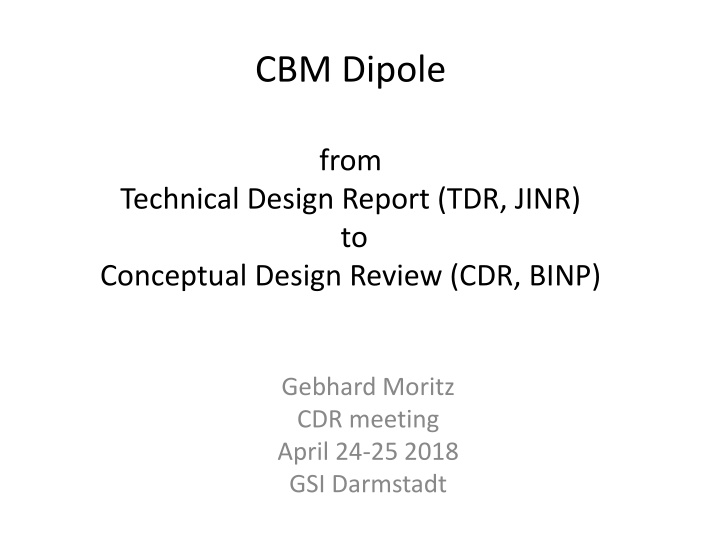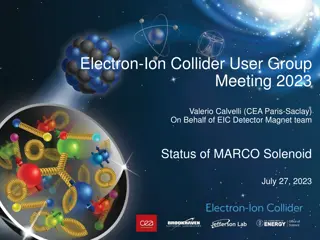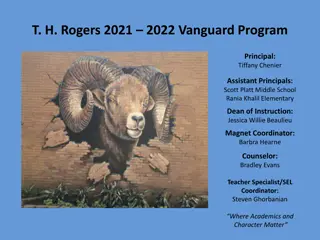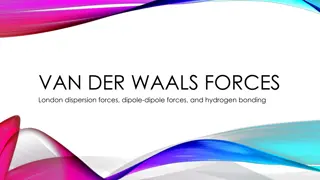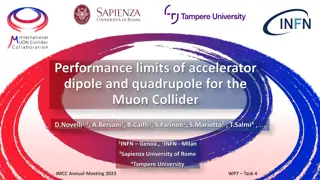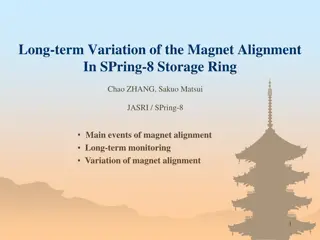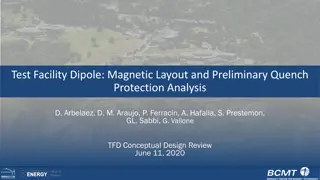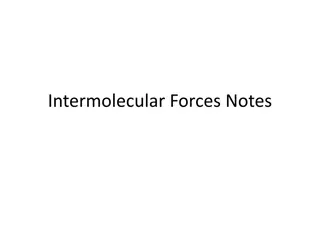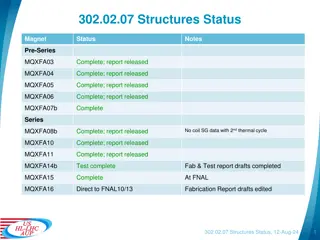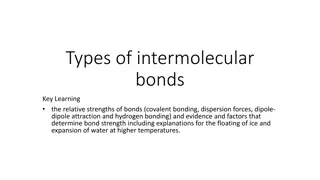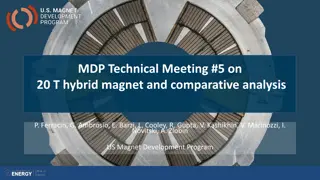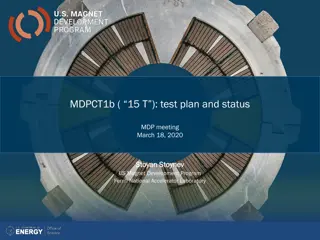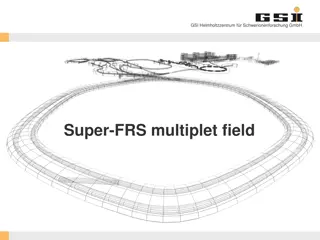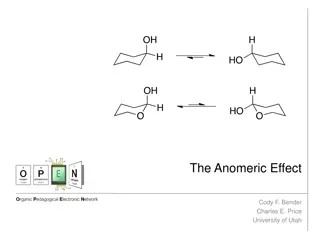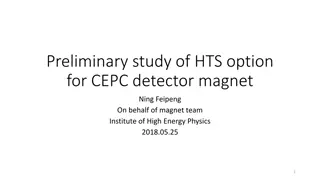Overview of CBM Dipole Magnet Design and Development
The CBM Dipole Magnet project, transitioning from Technical Design Report to Conceptual Design Review, involves key milestones such as the contract with BINP and recommendations from CDR meetings. The main parameters, construction details, coil structure, and conductor specifications are highlighted, showcasing the advanced technology and precision engineering behind the magnet's design and operation.
Download Presentation

Please find below an Image/Link to download the presentation.
The content on the website is provided AS IS for your information and personal use only. It may not be sold, licensed, or shared on other websites without obtaining consent from the author.If you encounter any issues during the download, it is possible that the publisher has removed the file from their server.
You are allowed to download the files provided on this website for personal or commercial use, subject to the condition that they are used lawfully. All files are the property of their respective owners.
The content on the website is provided AS IS for your information and personal use only. It may not be sold, licensed, or shared on other websites without obtaining consent from the author.
E N D
Presentation Transcript
CBM Dipole from Technical Design Report (TDR, JINR) to Conceptual Design Review (CDR, BINP) Gebhard Moritz CDR meeting April 24-25 2018 GSI Darmstadt
History CBM Dipole October 2013: TDR by JINR October 2016: Contract with BINP for the Design, production and delivery of the magnet including power converter, feed- and branchbox Assembly and operation test onsite Annex 3: Functional specification Annex 1: Milestones Conceptual Design Review (A) April 2017 recommendations Conceptual Design Review (B) April 2018, based on an informal report of February 2018
CBM Dipole main parameters Opening angle: 25 vertically, 30 horizontally from the target Free aperture: 1.44 m vertically x 3.0 m horizontally Distance target- magnet end: 1m (STS detector) Field integral within STS detector (along straight lines): 1 Tm Field integral variation over the whole opening angle along straight lines: 20% ( 10%) Fringe field downstream < reasonable value of the order of 50 to 100 Gauss at the position of the first RICH box. Operates at both polarities 100% duty cycle, 3 months/year, 20 years 1 hour up/down ramp
CBM dipole- general view TDR CDR based on the design of the SAMURAI dipole at RIKEN
CBM dipole conductor (highly stabilized by copper) TDR CDR CMS- wire- in- channel Cu to SC: 9:1 Co-extrusion Cu to SC: 7.4
CBM dipole - coil TDR CDR cross section identical no splice one splice, unit length 5 km number of layers: 53 number of turns per layer: 33 number of turns per pole: 1749
CBM dipole coil-structure TDR CDR Copper mandrel U profile Stainless steel U profile indirect cooling vacuum impregnation (epoxy with filler) no prestress applied Stainless steel mandrel Stainless steel coil casing direct cooling through channels wet winding prestress applied very different !!!
CBM dipole- coil cryostat TDR CDR SAMURAI proven design
CBM dipole - cooling TDR bath cooling, direct large helium volume heat load (4.5K) per coil (preliminary): 5 W CDR thermosyphon, indirect small helium volume heat load (4.5K) per coil (preliminary): 4 W eddy current loss in one copper U profile during the ramp: 4.5 W two cryogenic circuits (one per coil) one cryogenic circuit
CBM dipole thermosyphon cooling refer to Super-FRS dipole cooling, by Herv Allain et al., IRFU
CBM dipole - stability Main sources of instability: energy release by epoxy cracking energy release by conductor movement (friction) Consequences: make MQE large: 7.9 mJ (calculated by BINP) avoid even the smallest mechanical movement under magnetic forces < 10 m !!) avoid cracking of organic materials (small epoxy volumes, no tensile stress) avoid stick slip motion at interfaces pre-load the winding so that it stays under compression at low temperatures pay careful attention to the mechanical design of the supporting structure and differential thermal contraction careful structural analysis
CBM dipole - quench TDR self- protecting magnet 3D calculations (CIEMAT, GSI) Hot spot temperature < 160 K Quench voltage Vq =1200 V CDR self-protecting magnet with requested Hot spot temperature <200 K Quench voltage Vq<1200 V relevant conductor/coil parameter identical to TDR -> same results additional coupled circuit (copper case) two fully independent protection systems including quench detector, breakers and dump resistors. one protection system systems including quench detector, breaker and dump resistor.
CBM dipole leads, busbars TDR direct cooling standard copper leads CDR indirect cooling HTS leads (to be designed) busbars (to be designed)
CBM dipole recommendations after the first CDR 5/2017 Recommendation 3 (controversial) A particular feature of this magnet is that the coil has to slide during the energization against the fixed supporting plate. This generates energy release possibly inducing unwanted quenches. Considering that a similar magnet (SAMURAI) is operating successfully with coils immerged in a helium bath we recommend the same principles for the CBM dipole (including highly conductive plates) in order to reduce the technical risk. Therefore we strongly recommend a helium bath cooling. Recommendation 4 (controversial) For the coils we recommend two independent cooling circuits in parallel.
CBM dipole -comments/questions/concerns Stefania Farinon made 3D ANSYS calculations (refer to indico: material). comments: 1. I strongly suggest including in the structural analysis the force distribution coming from the electromagnetic analysis. A uniform distribution leads to an underestimation of stresses and strains. 2. Despite the fact that, in a perfectly symmetric system, horizontal forces should be null, in real life horizontal forces will be present and there has to be a mechanical system able to withstand them. You should at least evaluate the effect of a non-perfect positioning of the coil.
CBM dipole -comments/questions/concerns Comments by P. Fabbricatore, S. Farinon Struts: all faulty scenarios have been considered leading to a possible tensile load?? coil delamination leading to reduced cooling and conductor movement? thermal contraction coefficient to be measured! eddy currents in the copper profile (load on the ramp, forces in case of a quench) coil cooling: heat load of the struts to be measured! heat loads generally too optimistic? material properties ok? Samurai magnet cannot be longer considered a reference for CBM magnet design .
CBM dipole -comments/questions/concerns Comment by Alain Herv topic: Cu channel used as winding mandrel and also as cooling mandrel the bonding as it is standing on the inner diameter is submitted to tensile stress when energizing the coil. The risk of delamination of mandrel and turns is maybe limited during energization because of the limited value of the applied stress. However, I see a big risk of delaminating this very important bond during cool-down as the cooling circuit has to be kept much cooler than the coil, generating a dangerous gradient. cooling down from an internal mandrel is not really a recommended design
CBM dipole -comments/questions/concerns Comment by Alain Herv topic: new strut (pillar) design: difficult to understand its merits. more information (load, radial rigidity) is needed perfect symmetry is never guaranteed- deviations have to be accounted for (coil off-centered etc.)
CBM dipole -comments/questions/concerns Comment by Alain Herv topic: Interface between the pillars and the coil structure The possible sliding of the coil structure will appear between the Cu plate and the SS plate. Therefore 1) there is a risk of stick-slip movement during energizing that could be detrimental to stability because of heat generated by friction and un-controlled eddy currents. 2) there is a high risk of galling with a situation deteriorating with time and the number of cycles. The introduction of a sliding surface on top of the pillars could mitigate this risk.
Training: what to do and what not to do Do Don't use a composite conductor with as much copper as other design constraints allow allow helium to permeate the winding in direct contact with the conductors reinforce any resin or other organic material used with a low contraction material such as glass fibre pre-load the winding so that it stays under compression at low temperatures coat sliding interfaces with hard low friction materials and ensure they are well cooled match thermal contractions as closely as possible support the winding with a rigid structure that doesn't move much under magnetic loading allow any possibility of any turn to move under field forces use large volumes of clear resin or other organic material use any more resin or other high contraction material than necessary glue anything directly to the conductor allow 'stick slip' motion at interfaces, eg where the winding presses against the supporting structure allow the possibility of tensile or shear failure anywhere in the winding Superconducting Magnets for Accelerators GSI April 2001 Martin Wilson Lecture 4 slide21
